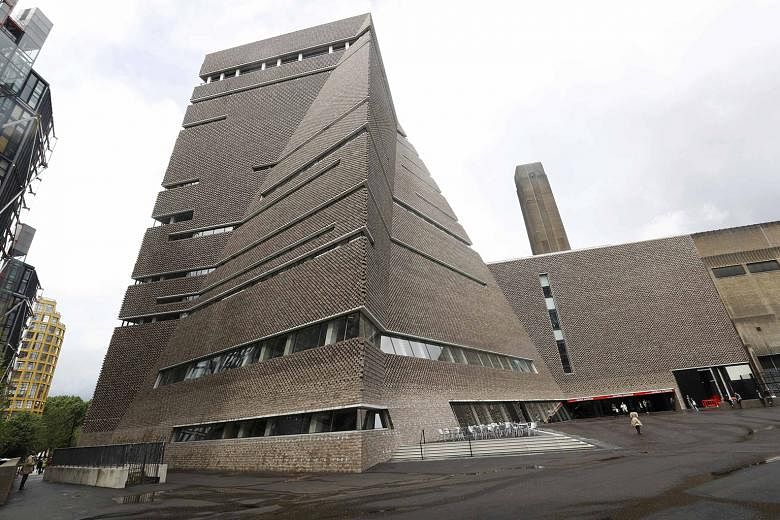LONDON • Yesterday, the world's most popular modern art museum, the Tate Modern, opened a new 10-storey wing designed by Swiss architects Jacques Herzog and Pierre de Meuron. Called the Switch House, the extension will show off contemporary work, including film and live performance, and will add 60 per cent more space to the already enormous former power station on the banks of the Thames.
Few anticipated when the Tate Modern opened in 2000 that it would transform the idea of a museum and nature of museum-going. Its director, Mr Nicholas Serota, hoped for two million visitors a year. More than five million have passed through its doors each year.
They have flocked to its gigantic Turbine Hall to watch a glowing "sunrise" from hundreds of tungsten lights in Olafur Eliasson's The Weather Project, sifted Ai Weiwei's hand-painted sunflower seeds through their fingers and heard actors telling intimate stories in Tino Sehgal's These Associations, among many highlights.
What will be in the new space? And what should you see first? Here is a user's guide to planning your first trip.
NAVIGATING THE SWITCH HOUSE
The new extension adapts parts of the original power station that the 2000 renovation by Herzog and de Meuron did not touch.
Adjacent to this older layer is a pyramidal tower about 65m tall, clad in perforated brick that the architects have described as looking like "knitwear".
You can enter from the huge Turbine Hall in the older building, passing through the subterranean Tanks, which once held a million gallons of oil to power the refinery.
The rehabilitation of the Tanks was the first phase of the new building in 2012. They are dedicated to performance art and experimental film. A sculptural concrete staircase curves up to three levels of exhibition space.
A bridge on Level 4 connects back to the older building (now called the Boiler House). Higher floors are devoted to education, offices and a members' room. So after gorging on art, head for the new restaurant on Level 9 and, for dessert, savour the wrap-around balcony on Level 10, with a 360-degree view of London.
THINKING OUTSIDE THE CUBE
Ms Catherine Wood, Tate Modern's senior curator, International Art (Performance), said: "It starts from the 1960s, when art became very active. There was a lot of rethinking of sculpture, creating objects that could be manipulated, rearranged, walked through and also listened to. The idea is really to show the global scope of what the museum has acquired in the last 10 years, and the kinds of pieces that don't need or want a white cube space."
The new building cost £260 million (S$500 million) from public and private funding, with the largest donation (£50 million) from the British government.
THE NEW EXHIBITIONS
In the East Tank and some adjacent spaces, look for light, sound, interactive sculpture and video works by original voices, including Marvin Gaye Chetwynd (video), Dominique Gonzalez-Foerster (shadow art), Wen-Ying Tsai and Apichatpong Weerasethakul (film). In the South Tank is interactive sculpture by Robert Morris, Charlotte Posenenske and Rasheed Araeen.
The South Tank is also the "anchor point" for live performance art. Levels 2, 3 and 4 present individually themed exhibitions.
These include Between Object And Architecture - on Level 2 - which looks at the way post-1960s artists employed geometric shapes and ordinary building materials such as bricks or cubes, and includes artists from Latin America and China as well as Europe, emphasising the museum's commitment to what Ms Frances Morris, director of the Tate Modern, called "a more global story of art".
WHAT THE PROS LIKE BEST
Mr Serota: "You can't visit the Tate without going to the Rothko Room (Level 2 of the Boiler House). Then look at a wonderful room of work by German artist Rebecca Horn on Level 3 of the Switch House. Next door, Ana Lupas, a Romanian artist who has been working from the mid-1960s, embalmed rural straw sculptures - it's very striking.
"Then go up to the Louise Bourgeois room on Level 4, where you can see some of the most important work of her career, made in the last 10 years of her life."
Ms Wood: "Take time to see some of the live performances in the South Tank. Walk up the staircase to Level 2 to see the sculpture display, then go to Level 4 and walk across the bridge that connects the two buildings, pausing to admire Ai's 6.7m-tall sculpture created from parts of dead trees, in the Turbine Hall below.
"Travel by escalator back down to the hall and take part in David Lamelas' interactive piece, Time."
Ms Morris: "In the Boiler House, the new introductory Start gallery offers Matisse's Snail. In The Studio features work by a great group of British artists: Antony Gormley, Anish Kapoor and Bridget Riley. Then head to the Switch House, begin in the Tanks and walk up the staircase to the Between Object And Architecture exhibition.
"Finally, take the elevator to the 10th floor, look at the view of London and remind yourself that it's the most cosmopolitan city in the world."
NEW YORK TIMES

